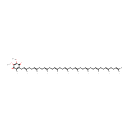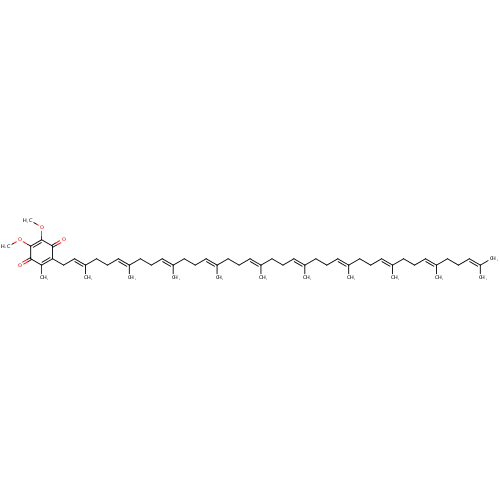|
Record Information |
|---|
| Version |
1.0 |
|---|
| Update Date |
1/22/2018 11:54:54 AM |
|---|
|
Metabolite ID | PAMDB000242 |
|---|
|
Identification |
|---|
| Name: |
Ubiquinone-10 |
|---|
| Description: | Ubiquinone-10 is a member of the chemical class known as Polyprenylbenzoquinones. These are compounds containing a polyisoprene chain attached to a quinone at the second ring position. Ubiquione-10 has 10 isoprene units. Normally in Pseudomonas aeruginosa the active form of Ubiquinone has 8 isoprene units (Ubiquinone-8) and in humans it normally has 10. Ubiquinone-10 is an extended version of Ubiquinone 8 that arises from conjugation by an extended prenyl tail via 4-hydroxybenzoate polyprenyltransferase. Ubiquionone is involved in cellular respiration. It is fat-soluble and is therefore mobile in cellular membranes; it plays a unique role in the electron transport chain (ETC). In the inner bacterial membrane, electrons from NADH and succinate pass through the ETC to the oxygen, which is then reduced to water. The transfer of electrons through ETC results in the pumping of H+ across the membrane creating a proton gradient across the membrane, which is used by ATP synthase (located on the membrane) to generate ATP. |
|---|
|
Structure |
|
|---|
| Synonyms: | - (all-E)-2,3-dimethoxy-5-methyl-6-(3,7,11,15,19,23,27,31-octamethyl-2,6,10,14,18,22,26,30-dotriacontaoctaenyl)-2,5-Cyclohexadiene-1,4-dione
- (all-E)-2-(3,7,11,15,19,23,27,31,35,39-decamethyl-2,6,10,14,18,22,26,30,34,38-tetracontadecaenyl)-5,6-dimethoxy-3-methyl-2,5-Cyclohexadiene-1,4-dione
- 2-(3,7,11,15,19,23,27,31,35,39-Decamethyl-2,6,10,14,18,22,26,30,34,38-tetracontadecaenyl)-5,6-dimethoxy-3-methyl-p-Benzoquinone
- 2-[(2E,6E,10E,14E,18E,22E,26E,30E,34E)-3,7,11,15,19,23,27,31,35,39-Decamethyl-2,6,10,14,18,22,26,30,34,38-tetracontadecaenyl]-5,6-dimethoxy-3-methyl- 2,5-Cyclohexadiene-1,4-dione
- 4-Ethyl-5-fluoropyrimidine
- Aqua Q 10L10
- Aqua Q10
- Bio-Quinon
- Bio-Quinone Q10
- Coenzyme Q10
- Coenzyme-Q10
- Coenzyme-Q10
- CoQ10
- Ensorb
- Kaneka Q10
- Kudesan
- Li-Q-Sorb
- Liquid-Q
- Neuquinon
- Neuquinone
- PureSorb Q 40
- Q 10AA
- Q-Gel
- Q-Gel 100
- Ubidecarenone
- Ubiquinone 10
- Ubiquinone 50
- Ubiquinone Q10
- Ubiquinone(10)
- Ubiquinone-10
- Unbiquinone
- Unispheres Q 10
|
|---|
|
Chemical Formula: |
C59H90O4 |
|---|
| Average Molecular Weight: |
863.3435 |
|---|
| Monoisotopic Molecular
Weight: |
862.683911368 |
|---|
| InChI Key: |
ACTIUHUUMQJHFO-UPTCCGCDSA-N |
|---|
| InChI: | InChI=1S/C59H90O4/c1-44(2)24-15-25-45(3)26-16-27-46(4)28-17-29-47(5)30-18-31-48(6)32-19-33-49(7)34-20-35-50(8)36-21-37-51(9)38-22-39-52(10)40-23-41-53(11)42-43-55-54(12)56(60)58(62-13)59(63-14)57(55)61/h24,26,28,30,32,34,36,38,40,42H,15-23,25,27,29,31,33,35,37,39,41,43H2,1-14H3/b45-26+,46-28+,47-30+,48-32+,49-34+,50-36+,51-38+,52-40+,53-42+ |
|---|
| CAS
number: |
303-98-0 |
|---|
| IUPAC Name: | 2-[(2E,6E,10E,14E,18E,22E,26E,30E,34E)-3,7,11,15,19,23,27,31,35,39-decamethyltetraconta-2,6,10,14,18,22,26,30,34,38-decaen-1-yl]-5,6-dimethoxy-3-methylcyclohexa-2,5-diene-1,4-dione |
|---|
|
Traditional IUPAC Name: |
coenzyme-Q10 |
|---|
| SMILES: | COC1=C(OC)C(=O)C(C\C=C(/C)CC\C=C(/C)CC\C=C(/C)CC\C=C(/C)CC\C=C(/C)CC\C=C(/C)CC\C=C(/C)CC\C=C(/C)CC\C=C(/C)CCC=C(C)C)=C(C)C1=O |
|---|
|
Chemical Taxonomy |
|---|
|
Taxonomy Description | This compound belongs to the class of organic compounds known as ubiquinones. These are coenzyme Q derivatives containing a 5, 6-dimethoxy-3-methyl(1,4-benzoquinone) moiety to which an isoprenyl group is attached at ring position 2(or 6). |
|---|
|
Kingdom |
Organic compounds |
|---|
| Super Class | Lipids and lipid-like molecules |
|---|
|
Class |
Prenol lipids |
|---|
| Sub Class | Quinone and hydroquinone lipids |
|---|
|
Direct Parent |
Ubiquinones |
|---|
| Alternative Parents |
|
|---|
| Substituents |
- Polyterpenoid
- Polyprenylbenzoquinone
- Ubiquinone skeleton
- Quinone
- P-benzoquinone
- Vinylogous ester
- Cyclic ketone
- Ketone
- Hydrocarbon derivative
- Organooxygen compound
- Carbonyl group
- Aliphatic homomonocyclic compound
|
|---|
| Molecular Framework |
Aliphatic homomonocyclic compounds |
|---|
| External Descriptors |
|
|---|
|
Physical Properties |
|---|
| State: |
Solid |
|---|
| Charge: | 0 |
|---|
|
Melting point: |
Not Available |
|---|
| Experimental Properties: |
|
|---|
| Predicted Properties |
|
|---|
|
Biological Properties |
|---|
| Cellular Locations: |
Membrane |
|---|
| Reactions: | |
|---|
|
Pathways: |
Not Available |
|---|
|
Spectra |
|---|
| Spectra: |
|
|---|
|
References |
|---|
| References: |
- Appelkvist EL, Edlund C, Low P, Schedin S, Kalen A, Dallner G: Effects of inhibitors of hydroxymethylglutaryl coenzyme A reductase on coenzyme Q and dolichol biosynthesis. Clin Investig. 1993;71(8 Suppl):S97-102. Pubmed: 8241713
- De Luca C, Filosa A, Grandinetti M, Maggio F, Lamba M, Passi S: Blood antioxidant status and urinary levels of catecholamine metabolites in beta-thalassemia. Free Radic Res. 1999 Jun;30(6):453-62. Pubmed: 10400457
- Folkers K, Hanioka T, Xia LJ, McRee JT Jr, Langsjoen P: Coenzyme Q10 increases T4/T8 ratios of lymphocytes in ordinary subjects and relevance to patients having the AIDS related complex. Biochem Biophys Res Commun. 1991 Apr 30;176(2):786-91. Pubmed: 1673841
- Hanisch F, Zierz S: Only transient increase of serum CoQ subset 10 during long-term CoQ10 therapy in mitochondrial ophthalmoplegia. Eur J Med Res. 2003 Nov 12;8(11):485-91. Pubmed: 14644702
- Kanehisa, M., Goto, S., Sato, Y., Furumichi, M., Tanabe, M. (2012). "KEGG for integration and interpretation of large-scale molecular data sets." Nucleic Acids Res 40:D109-D114. Pubmed: 22080510
- Lalani SR, Vladutiu GD, Plunkett K, Lotze TE, Adesina AM, Scaglia F: Isolated mitochondrial myopathy associated with muscle coenzyme Q10 deficiency. Arch Neurol. 2005 Feb;62(2):317-20. Pubmed: 15710863
- Littarru GP, Tiano L: Bioenergetic and antioxidant properties of coenzyme Q10: recent developments. Mol Biotechnol. 2007 Sep;37(1):31-7. Pubmed: 17914161
- Mancini A, Conte B, De Marinis L, Hallgass ME, Pozza D, Oradei A, Littarru GP: Coenzyme Q10 levels in human seminal fluid: diagnostic and clinical implications. Mol Aspects Med. 1994;15 Suppl:s249-55. Pubmed: 7752837
- Mancini A, De Marinis L, Oradei A, Hallgass ME, Conte G, Pozza D, Littarru GP: Coenzyme Q10 concentrations in normal and pathological human seminal fluid. J Androl. 1994 Nov-Dec;15(6):591-4. Pubmed: 7721661
- Miyake Y, Shouzu A, Nishikawa M, Yonemoto T, Shimizu H, Omoto S, Hayakawa T, Inada M: Effect of treatment with 3-hydroxy-3-methylglutaryl coenzyme A reductase inhibitors on serum coenzyme Q10 in diabetic patients. Arzneimittelforschung. 1999 Apr;49(4):324-9. Pubmed: 10337451
- Mosca L, Marcellini S, Perluigi M, Mastroiacovo P, Moretti S, Famularo G, Peluso I, Santini G, De Simone C: Modulation of apoptosis and improved redox metabolism with the use of a new antioxidant formula. Biochem Pharmacol. 2002 Apr 1;63(7):1305-14. Pubmed: 11960607
- Ogasahara S, Engel AG, Frens D, Mack D: Muscle coenzyme Q deficiency in familial mitochondrial encephalomyopathy. Proc Natl Acad Sci U S A. 1989 Apr;86(7):2379-82. Pubmed: 2928337
- Ogasahara S, Yorifuji S, Nishikawa Y, Takahashi M, Wada K, Hazama T, Nakamura Y, Hashimoto S, Kono N, Tarui S: Improvement of abnormal pyruvate metabolism and cardiac conduction defect with coenzyme Q10 in Kearns-Sayre syndrome. Neurology. 1985 Mar;35(3):372-7. Pubmed: 3974895
- Sekine K, Ota N, Nishii M, Uetake T, Shimadzu M: Estimation of plasma and saliva levels of coenzyme Q10 and influence of oral supplementation. Biofactors. 2005;25(1-4):205-11. Pubmed: 16873948
- Siciliano G, Mancuso M, Tedeschi D, Manca ML, Renna MR, Lombardi V, Rocchi A, Martelli F, Murri L: Coenzyme Q10, exercise lactate and CTG trinucleotide expansion in myotonic dystrophy. Brain Res Bull. 2001 Oct-Nov 1;56(3-4):405-10. Pubmed: 11719279
- Siemieniuk E, Skrzydlewska E: [Coenzyme Q10: its biosynthesis and biological significance in animal organisms and in humans]. Postepy Hig Med Dosw (Online). 2005;59:150-9. Pubmed: 15928598
- Singh RB, Niaz MA, Rastogi SS, Shukla PK, Thakur AS: Effect of hydrosoluble coenzyme Q10 on blood pressures and insulin resistance in hypertensive patients with coronary artery disease. J Hum Hypertens. 1999 Mar;13(3):203-8. Pubmed: 10204818
- Tomasetti M, Alleva R, Solenghi MD, Littarru GP: Distribution of antioxidants among blood components and lipoproteins: significance of lipids/CoQ10 ratio as a possible marker of increased risk for atherosclerosis. Biofactors. 1999;9(2-4):231-40. Pubmed: 10416035
- van der Werf, M. J., Overkamp, K. M., Muilwijk, B., Coulier, L., Hankemeier, T. (2007). "Microbial metabolomics: toward a platform with full metabolome coverage." Anal Biochem 370:17-25. Pubmed: 17765195
- Van Maldergem L, Trijbels F, DiMauro S, Sindelar PJ, Musumeci O, Janssen A, Delberghe X, Martin JJ, Gillerot Y: Coenzyme Q-responsive Leigh's encephalopathy in two sisters. Ann Neurol. 2002 Dec;52(6):750-4. Pubmed: 12447928
- Ye CQ, Folkers K, Tamagawa H, Pfeiffer C: A modified determination of coenzyme Q10 in human blood and CoQ10 blood levels in diverse patients with allergies. Biofactors. 1988 Dec;1(4):303-6. Pubmed: 3255359
- Zhou S, Zhang Y, Davie A, Marshall-Gradisnik S, Hu H, Wang J, Brushett D: Muscle and plasma coenzyme Q10 concentration, aerobic power and exercise economy of healthy men in response to four weeks of supplementation. J Sports Med Phys Fitness. 2005 Sep;45(3):337-46. Pubmed: 16230985
- Zierz S, Jahns G, Jerusalem F: Coenzyme Q in serum and muscle of 5 patients with Kearns-Sayre syndrome and 12 patients with ophthalmoplegia plus. J Neurol. 1989 Feb;236(2):97-101. Pubmed: 2709060
- Zierz S, von Wersebe O, Bleistein J, Jerusalem F: Exogenous coenzyme Q (coq) fails to increase coq in skeletal muscle of two patients with mitochondrial myopathies. J Neurol Sci. 1990 Mar;95(3):283-90. Pubmed: 2358821
|
|---|
| Synthesis Reference: |
Seo, Myung-Ji; Im, Eun-Mi; Hur, Jin-Haeng; Nam, Jung-Yeon; Hyun, Chang-Gu; Pyun, Yu-Ryang; Kim, Soon-Ok. Production of coenzyme Q10 by recombinant E. coli harboring the decaprenyl diphosphate synthase gene from Sinorhizobium meliloti. Journal of Micro |
|---|
| Material Safety Data Sheet (MSDS) |
Not Available |
|---|
|
Links |
|---|
| External Links: |
|
|---|


